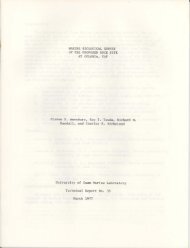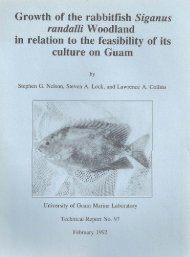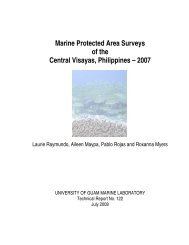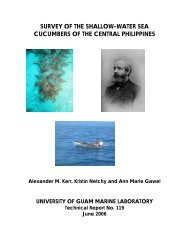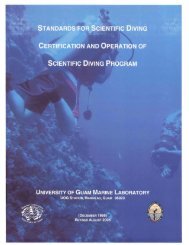Taxonomic inventories and assessments of terrestrial snails on the ...
Taxonomic inventories and assessments of terrestrial snails on the ...
Taxonomic inventories and assessments of terrestrial snails on the ...
Create successful ePaper yourself
Turn your PDF publications into a flip-book with our unique Google optimized e-Paper software.
MATERIALS AND METHODS<br />
Tinian, <strong>the</strong> third-largest isl<str<strong>on</strong>g>and</str<strong>on</strong>g> in <strong>the</strong> Mariana Isl<str<strong>on</strong>g>and</str<strong>on</strong>g>s, is located between latitude 14E55'<br />
N <str<strong>on</strong>g>and</str<strong>on</strong>g> 15E06' N <str<strong>on</strong>g>and</str<strong>on</strong>g> l<strong>on</strong>gitude 145E35' E <str<strong>on</strong>g>and</str<strong>on</strong>g> 145E40' E, some 8 km south southwest <str<strong>on</strong>g>of</str<strong>on</strong>g> Saipan<br />
<str<strong>on</strong>g>and</str<strong>on</strong>g> 128 km north <str<strong>on</strong>g>of</str<strong>on</strong>g> Guam (Figure 1). The isl<str<strong>on</strong>g>and</str<strong>on</strong>g> is about 20 km l<strong>on</strong>g <strong>on</strong> its north-south axis<br />
<str<strong>on</strong>g>and</str<strong>on</strong>g> 10 km wide <strong>on</strong> its east-west axis, with a l<str<strong>on</strong>g>and</str<strong>on</strong>g> area <str<strong>on</strong>g>of</str<strong>on</strong>g> about 102 km 2 . Basement Eocene<br />
volcanic rocks are overlain by Miocene <str<strong>on</strong>g>and</str<strong>on</strong>g> Plio-Pleistocene coral <str<strong>on</strong>g>and</str<strong>on</strong>g> algal limest<strong>on</strong>e <str<strong>on</strong>g>and</str<strong>on</strong>g><br />
Holocene raised beach <str<strong>on</strong>g>and</str<strong>on</strong>g> reef deposits. Doan et al. (1960) mapped <str<strong>on</strong>g>and</str<strong>on</strong>g> described five<br />
physiographic divisi<strong>on</strong>s <str<strong>on</strong>g>of</str<strong>on</strong>g> <strong>the</strong> isl<str<strong>on</strong>g>and</str<strong>on</strong>g>: 1) a high, sou<strong>the</strong>rn ridge, where <strong>the</strong> isl<str<strong>on</strong>g>and</str<strong>on</strong>g>’s highest<br />
elevati<strong>on</strong> (187 m) is located; 2) a low, median valley that bisects <strong>the</strong> isl<str<strong>on</strong>g>and</str<strong>on</strong>g> in a nor<strong>the</strong>astsouthwest<br />
directi<strong>on</strong>; 3) a large central plateau; 4) a small, north-central highl<str<strong>on</strong>g>and</str<strong>on</strong>g> with a<br />
maximum elevati<strong>on</strong> <str<strong>on</strong>g>of</str<strong>on</strong>g> 166 m; <str<strong>on</strong>g>and</str<strong>on</strong>g> 5) a nor<strong>the</strong>rn lowl<str<strong>on</strong>g>and</str<strong>on</strong>g> (Figure 2).<br />
Aguiguan is a small, steep-sided isl<str<strong>on</strong>g>and</str<strong>on</strong>g> <str<strong>on</strong>g>of</str<strong>on</strong>g> approximately 7.2 km 2 located 8 km southwest<br />
<str<strong>on</strong>g>of</str<strong>on</strong>g> Tinian at 14E51' N <str<strong>on</strong>g>and</str<strong>on</strong>g>145E33' E. The isl<str<strong>on</strong>g>and</str<strong>on</strong>g> is composed entirely <str<strong>on</strong>g>of</str<strong>on</strong>g> limest<strong>on</strong>e <str<strong>on</strong>g>and</str<strong>on</strong>g><br />
rises to an elevati<strong>on</strong> <str<strong>on</strong>g>of</str<strong>on</strong>g> 157 m. Most <str<strong>on</strong>g>of</str<strong>on</strong>g> <strong>the</strong> coastline c<strong>on</strong>sists <str<strong>on</strong>g>of</str<strong>on</strong>g> sheer limest<strong>on</strong>e cliffs rising<br />
abruptly from <strong>the</strong> sea in a series <str<strong>on</strong>g>of</str<strong>on</strong>g> eight separate terraces (Tayama <str<strong>on</strong>g>and</str<strong>on</strong>g> Ota, 1940). The terraces<br />
have been variously grouped into three (Butler, 1992) or four (Tayama <str<strong>on</strong>g>and</str<strong>on</strong>g> Ota, 1940) major<br />
terraces. The uppermost terrace forms a nearly flat, central plateau. There are no beaches or<br />
embayments (Figure 3).<br />
Terrestrial gastropod populati<strong>on</strong>s were surveyed by two methods. For arboreal species, a<br />
modificati<strong>on</strong> <str<strong>on</strong>g>of</str<strong>on</strong>g> <strong>the</strong> method used by Hopper <str<strong>on</strong>g>and</str<strong>on</strong>g> Smith (1992) was used. Thirty-minute visual<br />
surveys were c<strong>on</strong>ducted by observers in forested areas <str<strong>on</strong>g>of</str<strong>on</strong>g> <strong>the</strong> isl<str<strong>on</strong>g>and</str<strong>on</strong>g>s. Locati<strong>on</strong>s <str<strong>on</strong>g>of</str<strong>on</strong>g> sampling<br />
sites were determined by GPS (Garmin ® GPS 72). Presence or absence <str<strong>on</strong>g>of</str<strong>on</strong>g> <str<strong>on</strong>g>snails</str<strong>on</strong>g> was<br />
determined by examining leaves <str<strong>on</strong>g>of</str<strong>on</strong>g> broad-leaved tree species, including Hern<str<strong>on</strong>g>and</str<strong>on</strong>g>ia s<strong>on</strong>ora,<br />
Guamia mariannae, Cynometra ramiflora, Neisosperma oppositifolia, Ochrosia mariannensis,<br />
Mammea odorata, <str<strong>on</strong>g>and</str<strong>on</strong>g> Aglaia mariannensis, which serve as host species for partulids in o<strong>the</strong>r<br />
Mariana Isl<str<strong>on</strong>g>and</str<strong>on</strong>g>s. Special emphasis was given to re-visiting sites in Aguiguan where Partula<br />
langfordi, an Aguiguan endemic, <str<strong>on</strong>g>and</str<strong>on</strong>g> Partula gibba were reported historically (Craig <str<strong>on</strong>g>and</str<strong>on</strong>g><br />
Ch<str<strong>on</strong>g>and</str<strong>on</strong>g>ran, 1992; Smith, 1995; K<strong>on</strong>do, unpublished data). These species were listed as<br />
C<str<strong>on</strong>g>and</str<strong>on</strong>g>idate Species for protecti<strong>on</strong> under <strong>the</strong> U.S. Endangered Species Act. No published records<br />
<str<strong>on</strong>g>of</str<strong>on</strong>g> partulid tree snail distributi<strong>on</strong> in Tinian are known; K<strong>on</strong>do (1970) reported Partula gibba<br />
from Tinian, but he did not provide locality data.<br />
When live arboreal <str<strong>on</strong>g>snails</str<strong>on</strong>g> were located within <strong>the</strong> visual census period, 25-m 2 plots were<br />
established under <strong>the</strong> densest understory, as determined by a spherical densiometer. During a<br />
30-min search, all <str<strong>on</strong>g>snails</str<strong>on</strong>g> located to 2 m height within <strong>the</strong> plots were identified to species or<br />
collected <str<strong>on</strong>g>and</str<strong>on</strong>g> preserved in 75.5% ethanol for identificati<strong>on</strong> in <strong>the</strong> laboratory. Shell lengths <str<strong>on</strong>g>of</str<strong>on</strong>g><br />
specimens were measured to <strong>the</strong> nearest 0.1 mm with sliding vernier calipers (Digimatic ® 500-<br />
136, Mitutoyo Corp.) or with a Peak ® 10x Scale Loupe. Host tree species were recorded for each<br />
snail observed.<br />
Leaf litter was examined for 10 min in search <str<strong>on</strong>g>of</str<strong>on</strong>g> fresh partulid ground shells at each<br />
sampling site. Observati<strong>on</strong>s <str<strong>on</strong>g>of</str<strong>on</strong>g> dead ground shells were recorded. If no live <str<strong>on</strong>g>snails</str<strong>on</strong>g> or fresh<br />
2





